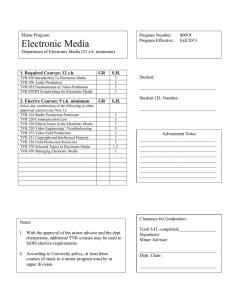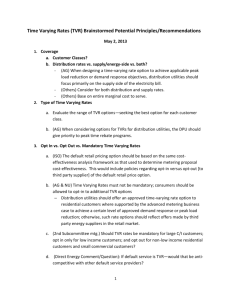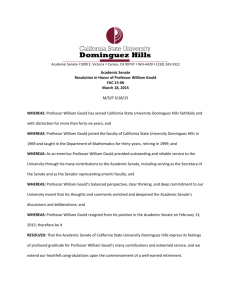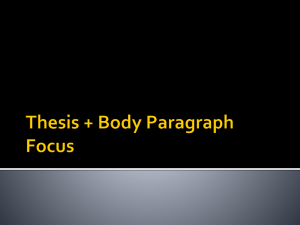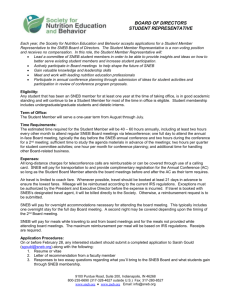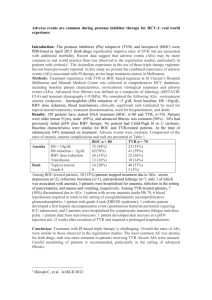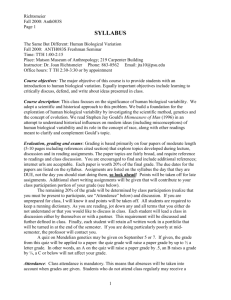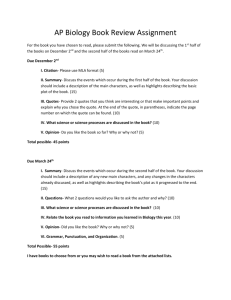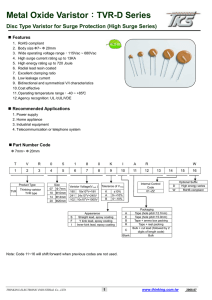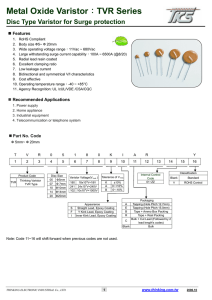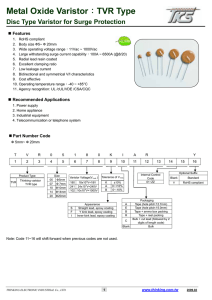Grading - Pasadena City College
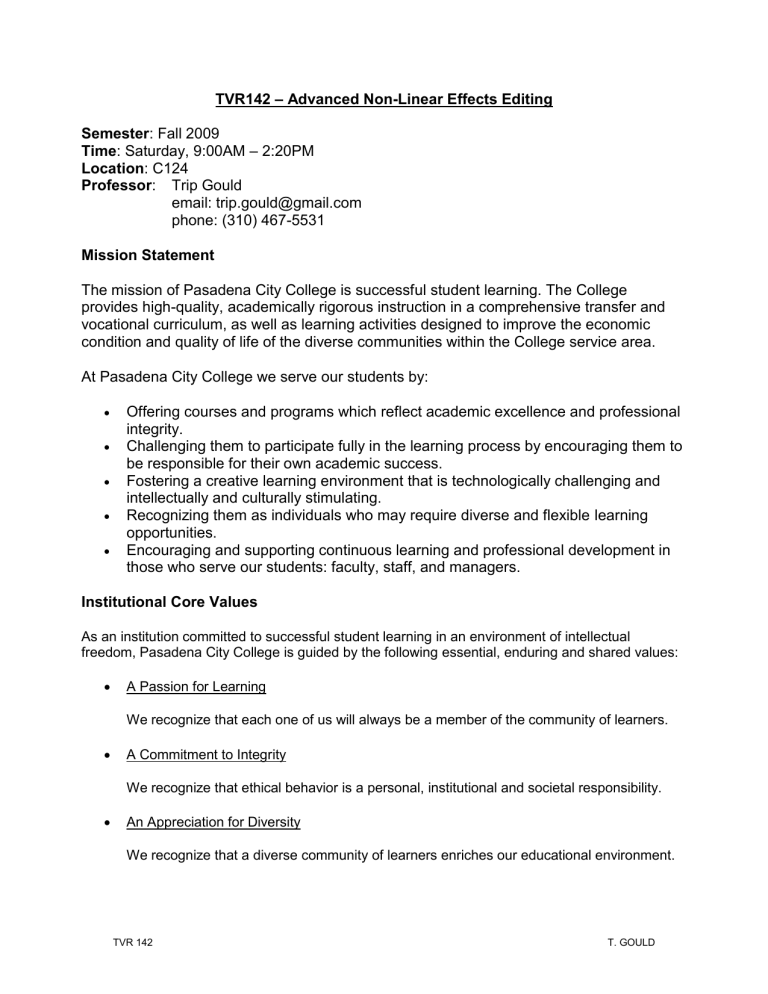
TVR142
– Advanced Non-Linear Effects Editing
Semester : Fall 2009
Time : Saturday, 9:00AM
– 2:20PM
Location : C124
Professor : Trip Gould email: trip.gould@gmail.com phone: (310) 467-5531
Mission Statement
The mission of Pasadena City College is successful student learning. The College provides high-quality, academically rigorous instruction in a comprehensive transfer and vocational curriculum, as well as learning activities designed to improve the economic condition and quality of life of the diverse communities within the College service area.
At Pasadena City College we serve our students by:
Offering courses and programs which reflect academic excellence and professional integrity.
Challenging them to participate fully in the learning process by encouraging them to
be responsible for their own academic success.
Fostering a creative learning environment that is technologically challenging and intellectually and culturally stimulating.
Recognizing them as individuals who may require diverse and flexible learning opportunities.
Encouraging and supporting continuous learning and professional development in those who serve our students: faculty, staff, and managers.
Institutional Core Values
As an institution committed to successful student learning in an environment of intellectual freedom, Pasadena City College is guided by the following essential, enduring and shared values:
A Passion for Learning
We recognize that each one of us will always be a member of the community of learners.
A Commitment to Integrity
We recognize that ethical behavior is a personal, institutional and societal responsibility.
An Appreciation for Diversity
We recognize that a diverse community of learners enriches our educational environment.
TVR 142 T. GOULD
A Respect for Collegiality
We recognize that it takes the talents, skills and efforts of the entire campus community, as well as the participation of the broader community, to support our students in their pursuit of learning.
A Recognition for Our Heritage of Excellence
We recognize that we dr aw upon the college’s rich tradition of excellence and innovation in upholding the highest standard of quality for the services we provide to our students and community.
Course Description
Prerequisite: TVR 141B or placement based on the TVR assessment process. Advanced visual effects editing using the Avid Editing System. Create, enhance, modify and treat stills, motion graphics and titling sequences (Adobe Photoshop, BorisFX). Troubleshoot system and peripheral devices and software. Total of 36 hours lecture and 54 hours laboratory. Formerly Telcm 142.
Student Learning Outcomes
By the end of this course, students should be able to:
1. Import and export graphic elements between the editing system and effects software like
Adobe Photoshop.
2. Create, enhance, modify, and treat stills and motion images with visual effects for use in video productions.
3. Edit video clips to create paint effects and animated mattes.
4. Apply the techniques of vertical layering, nesting, advanced keyframing and compositing to create visual effects.
5. Demonstrate advanced use of primary color correcting tools to adjust luminance and chrominance values of a clip or sequence.
6. Prepare advanced titling sequences.
7. Set-up personal shortcuts and tips for creating effects efficiently, minimizing render space and time.
8. Monitor and appropriately adjust signal flow and color/luminance values for FCC technical compliance and safe broadcast limits.
9. Troubleshoot system and peripheral devices and software to reduce technical downtime.
TVR 142 T. GOULD
Late Work
If you miss deadlines in the “real world,” you will damage your professional reputation and possibly be fired. Therefore late assignments will be penalized at the rate of 1/3 letter grade per class period. No extensions will be granted except in cases of dire emergency.
Academic Integrity
The mission of Pasadena City College includes cultivating in each student not only academic and life skills, but also the characteristics of integrity. It is therefore part of the mission of the College to nurture in each student a sense of moral responsibility.
Furthermore, a breach of academic integrity is viewed not merely as a private matter between the student and an instructor, but rather as an act which is fundamentally inconsistent with the purpose and mission of the entire College.
Class Participation
Attending class is not optional; it is a course requirement. If you miss a lecture, it is your responsibility to get the notes from a classmate. A student who accumulates three or more unexcused absences will forfeit 1/3 letter grade from his/her final average. However, attendance alone will not be sufficient to fully absorb everything this class has to offer.
Class participation is an integral component of the teacher/student relationship. Though I can not force you to make an active contribution to class discussions, I can promise you that you will only be limiting your own growth and progress if you merely occupy a seat in class and refrain from engaging and challenging myself and your fellow students with your thoughts and insights.
Extra Credit
If you are concerned about your standing in the class, or you feel that your performance, for whatever reason, is not representative of your effort or ability, or you just like to do extra work, various extra credit assignments can be arranged. Except in very special cases, however, and you will have to make your case, there will be a cap on extra credit at
50 total points.
Office Hours
I will be available for consultation for the hour preceding class each week. Should you need to meet outside of these “office hours,” I’m sure we can work something out. I will also be available via email and/or phone. I will never penalize you for seeking aid and there is no limit to how much additional support you are allowed to request from me. Just bear in mind that I have many obligations outside of PCC, and that any meetings beyond the standard pre-class hour will be contingent upon my schedule. In other words, plan on requesting additional office hours as far in advance as possible if you hope to actually get them. This is both to ensure you get all of the help you need, and as a courtesy to me.
TVR 142 T. GOULD
Introduction to Media Composer o What’s different in MC o Keyboard layout o Review of basic editing techniques
Introduction to transitions o Quick transitions o Adjusting parameters o Transitions from Effects Palette
Introduction to the Effects Palette o Color coding o Applying effects o Changing effect parameters o Working in effect mode o Working with keyframes / advanced keyframes
The Title Tool o Creating / manipulating titles o Rolls and Crawls o Mattes / Fills
The Marquee Title Tool (tentative) o Introduction to the interface o Creating and manipulating titles o Integration with the MC timeline
Compositing o Layering / nesting o Keys – Luma / Chroma
Motion effects o Creating and manipulating o Timewarps / freeze frames
Color Correction o Introduction to the interface o Basic techniques o Secondary correction / advanced tools
Introduction to the tracker o Using the tracker o Using the stabilizer
Paint tool o Blurring / replacing objects in a frame
Exporting projects to Quicktime for submission
TVR 142 T. GOULD
Grading
9 Exercises (900 points/100 points per exercise)
Class Participation (100 points)
Your final grade will be assessed on a 1000-point scale. Letter grades will be assigned by the following point values:
900 - 1000 = A
800 - 899 = B
700 - 799 = C
600 - 699 = D
0 - 599 = F
A Word on Grading
It is important to note that grades are not an assessment of your quality as a human being.
They are an assessment of the quality of your work and learning efforts in this class. I also ascribe great value to a student’s attitude and a demonstration of improvement; it’s not how you begin, it’s how you finish. That is why assignments become more valuable as the semester progresses. That said, each step along the way is valuable and critical and a constant effort to learn and improve will serve you well in this class.
Please note that a “B” is a good grade that represents “competent and complete” work.
“A” grades are earned only by “superior” work. It is not impossible to earn an “A,” but it is difficult. If you make a thorough attempt to learn, that’s a “B.” If you go beyond what the majority of your peers do to learn and to create, that’s an “A.”
A = Excellent creative and integrative work, revealing superior creativity, analysis and learning.
B = Good work, competent and complete in accomplishing learning outcomes
C = Adequate work, may have some competence to develop in learning outcomes
D = Less than adequate work, lacking competence in many learning outcomes
F = Completely fails to meet expectations in learning outcomes
TVR 142 T. GOULD
